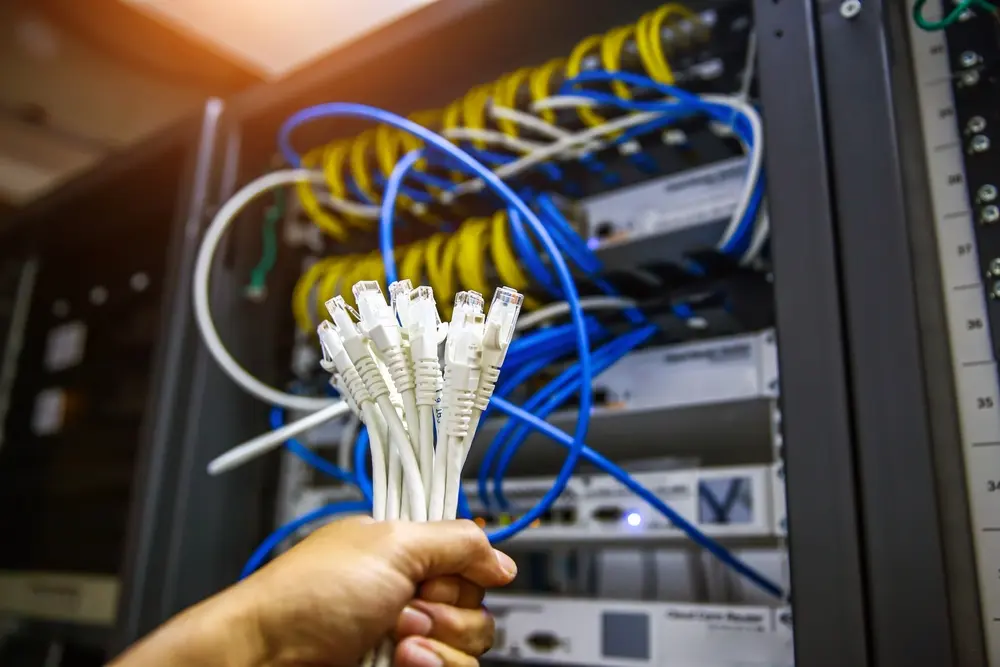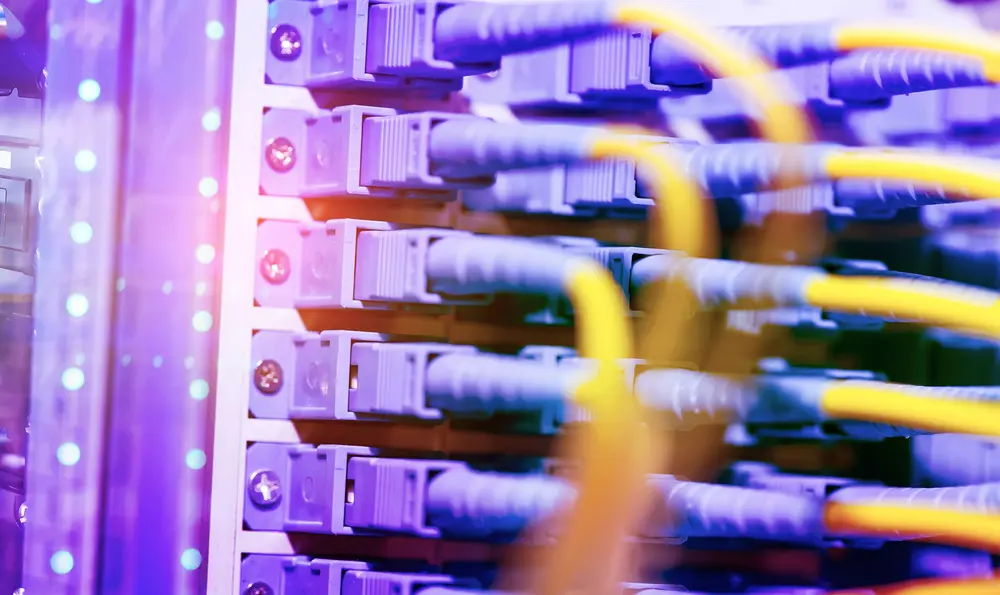In today’s digital age, where connectivity is the cornerstone of any successful enterprise, fiber optics is a vital component in driving performance and efficiency. This technology, which uses glass or plastic wires to transmit data at astonishing speeds using pulses of light, offers a number of advantages and benefits that transform the way companies manage their operations and connect with the world. Below is a breakdown of some of the main advantages and benefits of fiber optics, highlighting its importance in the business context.
High speed and bandwidth:
Fiber optics provides significantly faster data transmission speeds compared to traditional technologies such as coaxial cable or twisted pair. This high-speed capability enables the rapid transfer of large volumes of data, optimizing business operations and improving overall efficiency. Fiber optic speed is essential for businesses that rely on fast data transmission, such as those that conduct video conferencing, telecommuting or use bandwidth-intensive applications.
Expanding bandwidth capacity is a continuous improvement in fiber optics. As enterprises adopt cloud applications and services, the need for increased capacity becomes imperative. The research seeks to expand data transmission capacity, allowing companies to handle large volumes of information efficiently and without compromising speed.

Reliability and stability:
Optical fiber is immune to electromagnetic interference and adverse weather conditions that can affect other forms of connectivity, such as copper cable. This immunity ensures a stable and reliable connection at all times, reducing downtime and providing continuity in business operations. Fiber optic stability is essential for companies that cannot afford interruptions in their connectivity, such as those that operate critical services or rely heavily on cloud applications.
Longer distance without signal loss:
Unlike copper solutions,optical fiber allows data transmission over much greater distances without significant signal loss. This extended reach is crucial for companies with multiple locations or requiring long-distance connections. Fiber optics provides the flexibility to connect branch offices, remote offices and data centers efficiently, regardless of distance.
Data security:
Fiber optics offers a higher level of data security due to its nature. Since it transmits data using pulses of light, it is much more difficult to intercept compared to the electrical signals used in other types of cables. This feature makes fiber optics the ideal choice for companies that handle confidential information or require high security standards to comply with regulations and standards.
Fiber optic upgrades are not only aimed at improving speed and capacity, but also at strengthening the security of data transmission. The implementation of advanced encryption and intrusion protection techniques helps to ensure the integrity and confidentiality of transmitted information.
Scalability and flexibility:
Fiber optics is inherently scalable, which means it can easily adapt to the growth of a company’s connectivity needs. As business operations expand, fiber optics allow for increased bandwidth without compromising connection quality. This flexibility is essential for companies looking for a long-term solution that can evolve with their changing demands.
Lower latency:
The low latency provided by fiber optics is crucial for real-time applications such as video conferencing, real-time data transmission and cloud services. Fast data transmission reduces delays and improves the user experience, which is especially relevant for companies that rely on real-time interactions with customers, partners or automated systems.
Facilitates digital transformation:
In the context of digital transformation, where companies are looking to adopt innovative and efficient technologies, fiber optics is a key enabler. It provides the infrastructure needed to implement emerging technologies such as the Internet of Things (IoT), artificial intelligence (AI) and machine learning, enabling companies to embrace innovation and stay ahead in their respective industries.
Lower maintenance and long-term costs:
Fiber optics require less maintenance compared to copper solutions, as they are not susceptible to corrosion and have a longer service life. While the initial investment may be higher, long-term costs are typically lower due to the durability and reliability of fiber optics needed to implement emerging technologies such as the Internet of Things (IoT), artificial intelligence (AI) and machine learning, allowing companies to embrace innovation and stay ahead of the curve in their respective industries.
Facilitates cloud connectivity:
Fiber optics provides an ideal connection to access and leverage cloud services. High speed and low latency ensure fast and efficient access to cloud applications and resources, which is essential for enterprises using cloud-based solutions for storage, data processing and online collaboration.
Improve customer experience:
Fiber optic connectivity enhances the customer experience by ensuring clear and fluid communication, fast response times and seamless access to online services. This is critical for customer-centric companies looking to build strong relationships and deliver quality services.
Developments in multimode optical fiber:
Multimode optical fiber, which allows the simultaneous transmission of multiple light signals through its core, is undergoing significant advances. These developments seek to improve transmission capacity over short and medium distances, which is beneficial for enterprise environments where connectivity is required in specific areas without compromising speed and transmission quality.
Thinner and lighter optical fiber:
Research is focused on creating thinner and lighter optical fibers while maintaining their transmission capacity. These more compact fibers not only make them easier to install in tight spaces, such as subway ducts or overhead ducts, but can also improve overall cable-laying efficiency in densely populated urban environments.
Reduction of signal attenuation:
Signal attenuation, the loss of light intensity as it travels along the optical fiber, is a challenge that is being addressed with improvements in materials and manufacturing techniques. By reducing attenuation, a greater distance in data transmission is achieved without significant loss of signal quality, resulting in more reliable connectivity.
Integration of emerging technologies:
Fiber optics is not only improved in terms of its basic transmission capacity, but also integrated with emerging technologies. The combination of fiber optics with technologies such as artificial intelligence (AI) and the Internet of Things (IoT) opens up new possibilities for automation and smarter decision making in enterprise environments.
The ability of optical fiber to transmit data through pulses of light allows for impressive speeds that far exceed traditional transmission media. This rapid flow of information translates directly into operational efficiency for businesses, facilitating the completion of tasks and operations at a speed that redefines the boundaries of business productivity.
A fundamental aspect that distinguishes optical fiber is its ability to maintain signal integrity over considerably longer distances compared to other transmission media. Optical fiber minimizes signal attenuation, ensuring that information arrives clearly and without loss of quality, even in long-distance deployments. This reliability is essential for enterprise connectivity, where network consistency and availability are imperative.

Data security is another area where fiber optics shines. Its ability to resist signal interception provides an additional level of protection for business-critical information. The implementation of advanced encryption techniques coupled with the inherent security of fiber-optic transmission creates a robust environment that safeguards the confidentiality and integrity of business data.
Fiber optics is not just a data transmission technology; it is a transformative force driving the evolution of enterprise connectivity. Its speed, reliability, security and massive bandwidth capacity make it an essential choice for businesses looking to thrive in an increasingly digital and competitive environment. By integrating fiber optics into the network infrastructure, companies not only improve their current performance, but also strategically position themselves to embrace the future opportunities of the digital revolution. Fiber optics is the backbone that supports the connected future of business and society as a whole.



